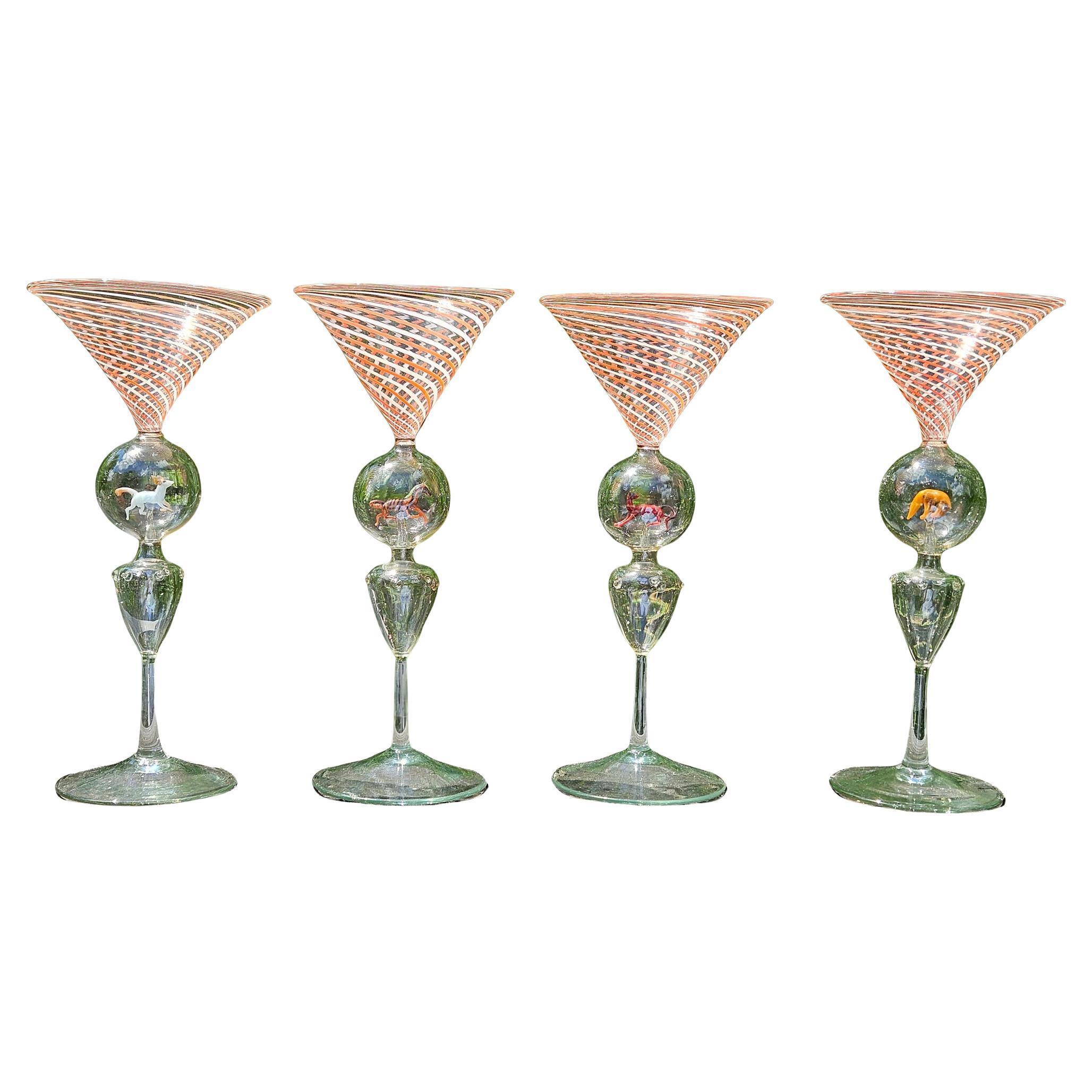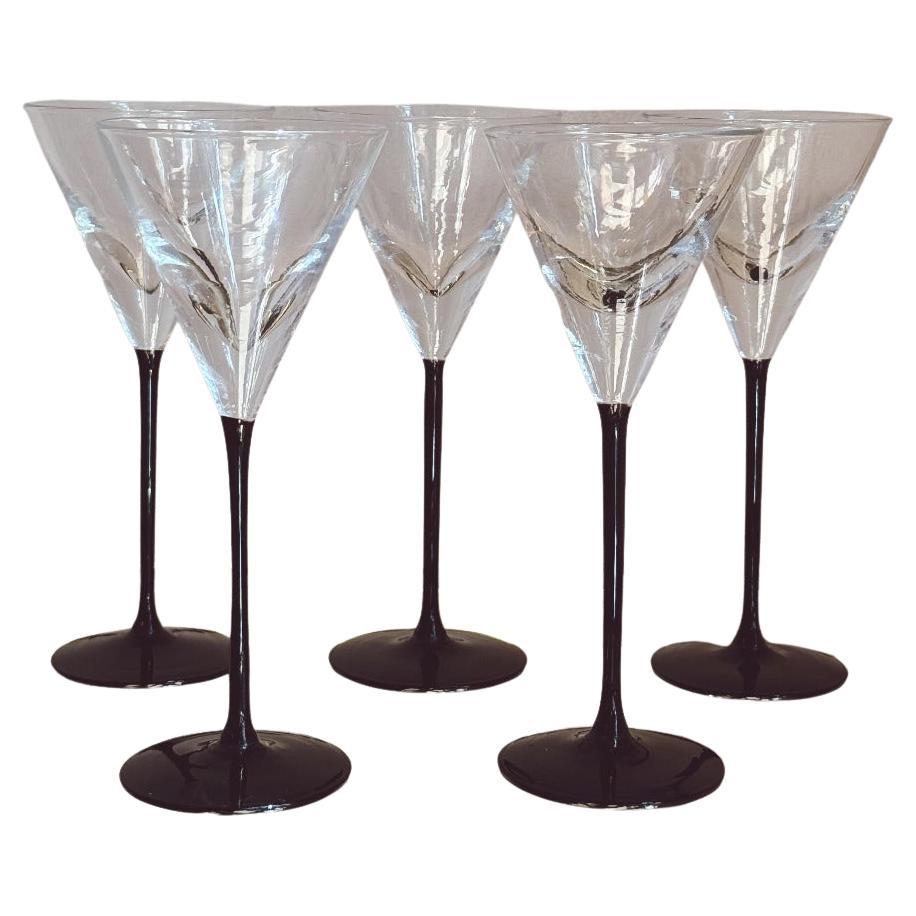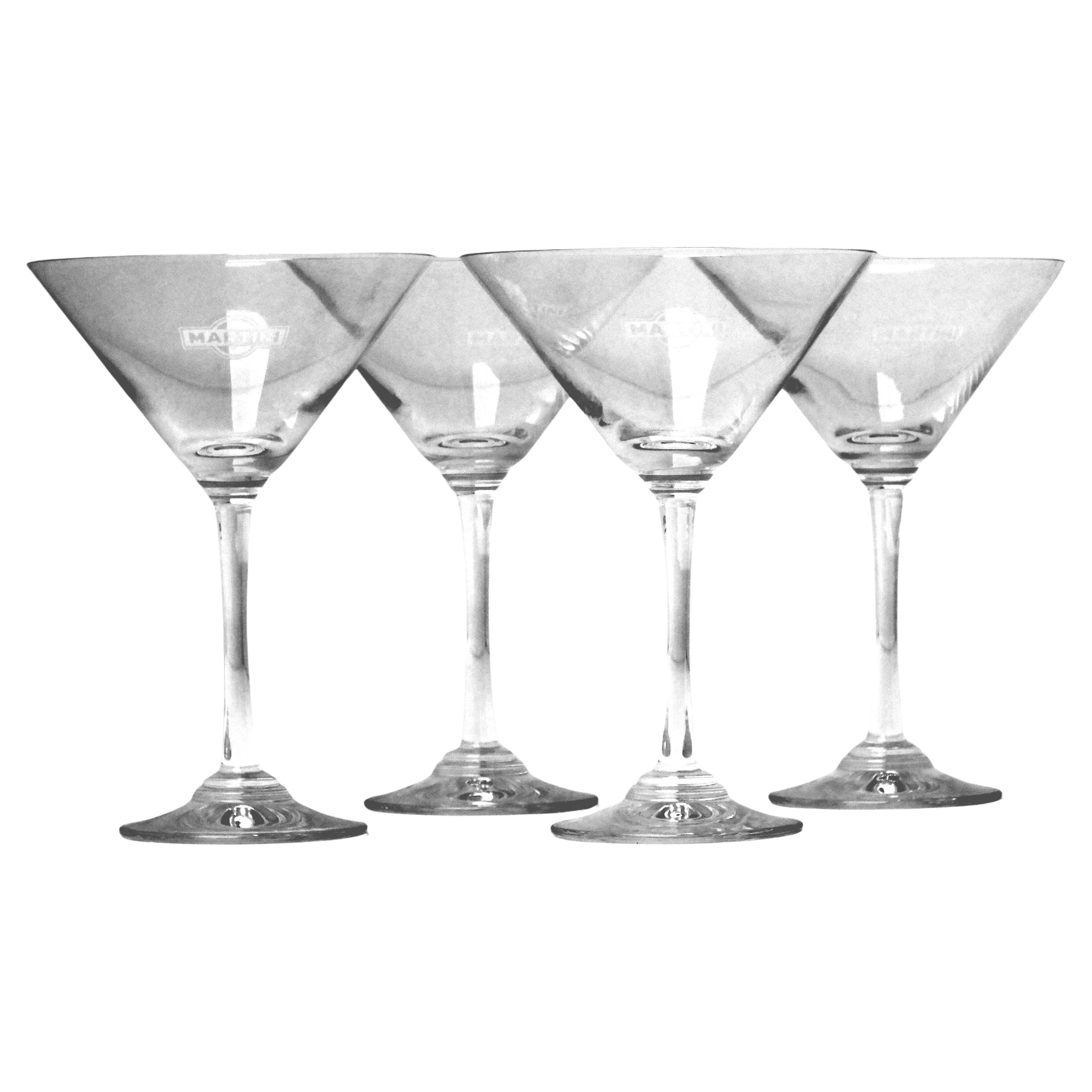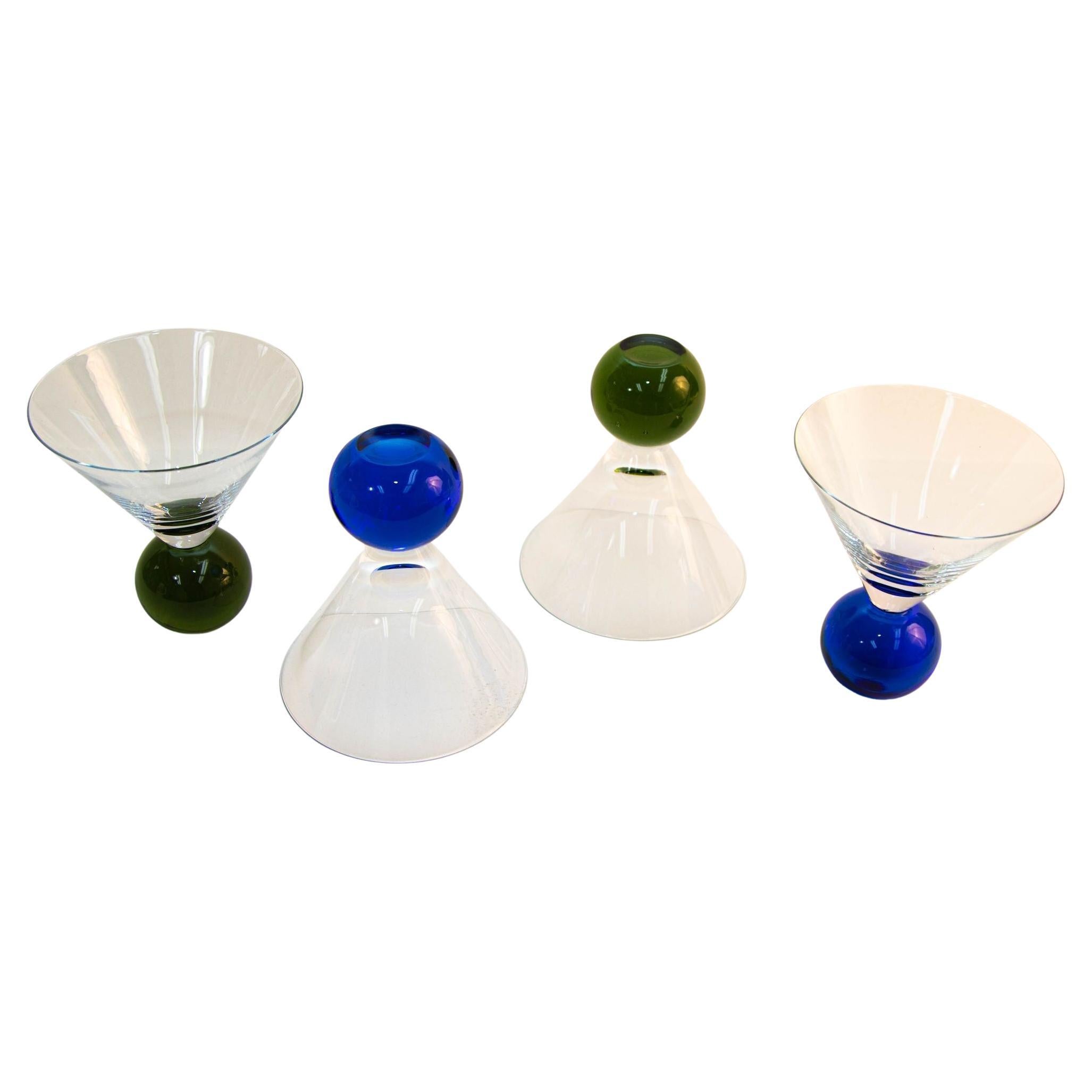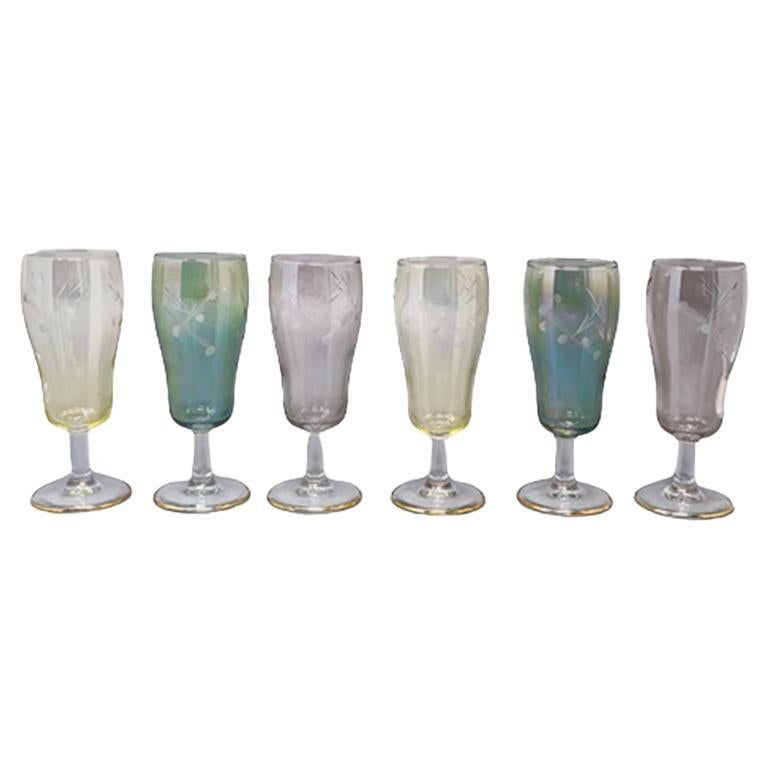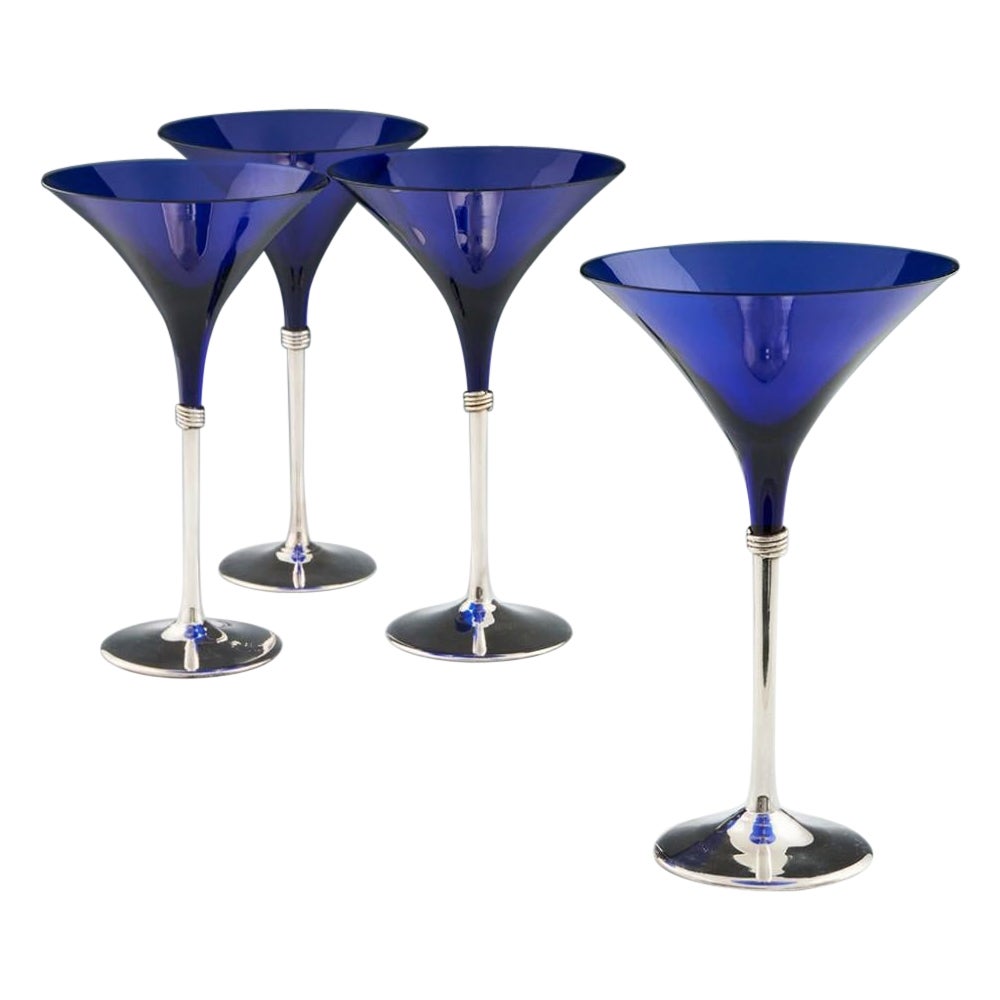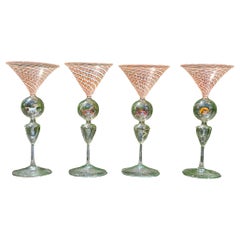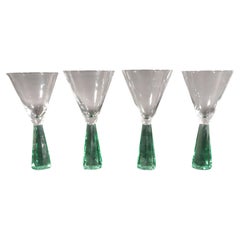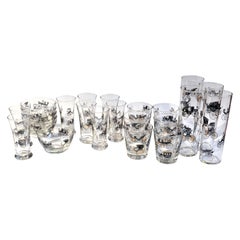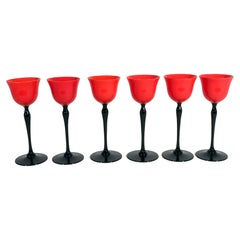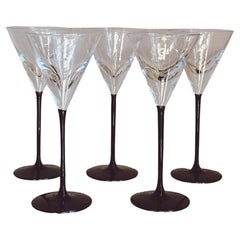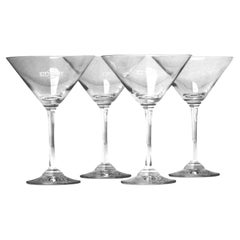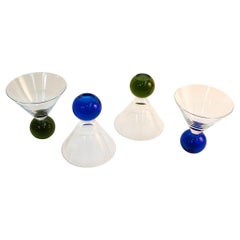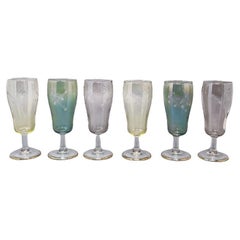Items Similar to Bimini Animal Martini Cocktail Glasses- Set of Four
Want more images or videos?
Request additional images or videos from the seller
1 of 14
Bimini Animal Martini Cocktail Glasses- Set of Four
$1,500per set
£1,126.84per set
€1,299.43per set
CA$2,081.45per set
A$2,312.95per set
CHF 1,212.01per set
MX$28,364.15per set
NOK 15,458.45per set
SEK 14,542.75per set
DKK 9,698.41per set
Shipping
Retrieving quote...The 1stDibs Promise:
Authenticity Guarantee,
Money-Back Guarantee,
24-Hour Cancellation
About the Item
Bimini Animal Martini Cocktail Glasses with Animals- Set of Four,
Circa 1925-35
The Bimini footed cocktail glasses have two central "bubbles". The lower one is of a teardrop shape and is hollow with the outside studded (prunts) like 17th-century glass to help hold it. Above is a globe-shaped bubble with a different animal within. The top is a conical-shaped martini glass with orange and white swirls. The animals include a bird, a dog, and two foxes.
Dimensions: 7 1/4 inches high x 3 1/8 inches wide
BIMINI
The Glass Museum
Raymond Berger is the son of Joseph Berger and nephew of Fritz Lampl, founders of Bimini Glass
Bimini and Orplid were linked by one man, a poet, artist, and dreamer, a man of ideas but with a streak of practicality, enough to run successive businesses for over thirty years. That man was Fritz Lampl, an Austrian, born in Vienna in 1892 and brought up in a suburb of that city where there was a large Jewish population. His father was a corn merchant and he had two elder brothers, August an architect, and Paul a banker.
Fritz became a poet, with poems published in the leading literary review The Brenner and short stories published by a German publisher called Jakob Hegner. Fritz was 22 when war broke out in Europe in 1914, with Germany and Austria fighting against Britain, France and their allies. His brother August was killed in one of the first battles of that war, and his other brother Paul, an officer in the army, was also killed. The rules of war in Austria at that time exempted from military service other sons of any family which lost two sons; so Fritz continued with his writing career.
During the war Fritz and his writer and artist friends used to meet in the Cafe Herrenhof, which had replaced the Zentral as the meeting place of interllectuals. It was here that he met Hilde Berger, sister of two architect/designers, Joseph and Artur Berger; and when the war ended he married Hilde.
After the war a group of writers, led by Fritz Lampl and Albert Ehrenstein, formed a writers' cooperative and published a small number of slim volumes, including Fritz's comedy The Flight. This publishing venture failed to make any profit and Fritz did not even receive his salary.
Shortly afterwards Fritz visited an exhibition in Berlin which included fantasy shapes in blown glass by Marianne von Allesch. He described these as "poetry materialised" and decided that he too would make "frozen poetry" in glass.
Bimini
In 1923 Fritz Lampl rented a basement, employed an out-of-work industrial glassblower, and invited his brother-in-law, Joseph Berger, to design fantasy shapes and sit beside the glassblower working together to convert the designs into glass. They worked with glass tubes of different diameters and colors, some of them striped. Joseph Berger described their work as follows:
First a mouthpiece was formed and then the man suddenly turned up the burner until the glass grew red hot and pliable, expanding as he blew into it, twisting, reheating, and finally cutting the bubble with a knife to form a foot; a vase had been born. There was great virtuosity in handling such brittle material, like taming an obstinate animal. It had to be married to sensitivity to turn craft into art.
We learned quickly from each other and soon fantastic animals, vases and figures emerged, which the glass blower then multiplied on his own. Fritz soon took my place as the designer and other artists were attracted by the fascinating game.
The name Lampl chose for his company, Bimini, is from a poem by Heinrich Heine about a fictional island called Bimini. Here is an extract:
Little Birdie Colibri,
Lead us on to Bimini
Fly ahead and we shall follow
In beflagged barges hollow;
On the Isle of Bimini
Reigns eternal ecstasy
And the golden larks are singing
In the Blue their tirili
by Heinrich Heine.
A flowerpot logo was decided upon, registered, craftsmen engaged, and a workshop set up. The date was November 1923. Very soon afterwards magazines were showing illustrations of Bimini glass and stores were buying them.
Labels with the logo were stuck to the various objects the workshop produced. Unfortunately they have mostly dropped off making identification of genuine Bimini items difficult. There have been many imitators ofBimini both Pre and Post World War II. Bimini has come to be used among some people as a generic term for any lamp blown glass from Continental Europe prior to World War II.
Output from the workshop was varied and extensive. The Bimini glass figurines are so beautiful they are like frozen moments in glass, or as they were described by Lampl "frozen poetry".
Many Bimini figurines use only one colour, and only rarely more than two. There is a correctness in anatomy and posture; they are abstract and lack detailed features. But always they convey a feeling, an emotion, and movement.
Coloured glass animals were also popular, as were the many designs of glasses, vases, and even glass cacti in ceramic flowerpots!
Joseph and Artur Berger were active in the firm both as designers of actual glass objects, which were then realised by the craftsmen, and also as designers of the Bimini showrooms, display cabinets and even notepaper.
Joseph Berger, who wrote an account of Bimini and Orplid shortly before his death in 1989, maintained that he and his brother acted as a restraint to some of the more kitsch and sentimental aspects of the glass. Joseph was a student of the famous Modernist architect Adolf Loos.
Fritz Lampl continued to write poetry during this period in Vienna, and the reception room of the home the Lampls shared with Hilde's sister, became a literary salon in the evening after work. Amongst the many visitors who came for advice, inspiration, or conversation, was H.M.Hauer (inventor of 12 tone music), Paul Engelmann, and his friend Wittgenstein.
Distinguishing features of Bimini, on the whole, were the delicacy of the lamp blown glass and the elegant design. Many of the items featured swirling patterns, either in white or coloured glass, somewhat in the Venetian latticino style.
The success of the firm was considerable, gaining a number of prizes at a Paris exhibition of 1925 and exhibiting throughout Europe and the USA. In Vienna the Bimini showrooms were set up in Stubenring, a fashionable address near the Museum of Arts and Crafts. Their glass became collectors items and they were very popular.
But Bimini was to be overtaken by world events, and the rise of Nazism in Austria meant that it was no longer safe for Jewish people to live and work there. Joseph Berger emigrated to England in 1936, and Artur Berger moved to Russia where he was to spend the rest of his life, working as an Art Director for Mosfilms. Fritz Lampl stayed in Vienna until 1938, when he joined the queue of alarmed Jews who hoped to emigrate to England. The British interviewers were encouraging craftsmen to emigrate to Britain, they were not accepting many merchants. Fritz took some samples of Bimini glasses and photos of his wife's model dresses to the interview, and successfully gained a visa for himself and his wife.
Secret Nazi organisations had penetrated Viennese society by this time, and people in Vienna stopped trusting one another. Fritz and Hilde made their preparations to leave in secrecy, and took with them only a few examples of his work. They left so secretly, in fact, that his assistant did not know he was leaving, and arrived for work at the Bimini shop to find that her boss had fled. She was later to donate many examples of Bimini glass to the Applied Arts Museum in Vienna.
(Ref: NY9757-prr)
- Creator:Bimini Glass (Designer)
- Dimensions:Height: 7.25 in (18.42 cm)Diameter: 3.13 in (7.96 cm)
- Sold As:Set of 4
- Style:Art Deco (Of the Period)
- Materials and Techniques:
- Place of Origin:
- Period:
- Date of Manufacture:19203-30s
- Condition:
- Seller Location:Downingtown, PA
- Reference Number:Seller: NY9757-prrx1stDibs: LU861044897592
About the Seller
5.0
Recognized Seller
These prestigious sellers are industry leaders and represent the highest echelon for item quality and design.
Platinum Seller
Premium sellers with a 4.7+ rating and 24-hour response times
Established in 1916
1stDibs seller since 2009
414 sales on 1stDibs
Typical response time: 1 hour
Associations
The Art and Antique Dealers League of AmericaAntiques Associations Members
- ShippingRetrieving quote...Shipping from: Downingtown, PA
- Return Policy
Authenticity Guarantee
In the unlikely event there’s an issue with an item’s authenticity, contact us within 1 year for a full refund. DetailsMoney-Back Guarantee
If your item is not as described, is damaged in transit, or does not arrive, contact us within 7 days for a full refund. Details24-Hour Cancellation
You have a 24-hour grace period in which to reconsider your purchase, with no questions asked.Vetted Professional Sellers
Our world-class sellers must adhere to strict standards for service and quality, maintaining the integrity of our listings.Price-Match Guarantee
If you find that a seller listed the same item for a lower price elsewhere, we’ll match it.Trusted Global Delivery
Our best-in-class carrier network provides specialized shipping options worldwide, including custom delivery.More From This Seller
View AllBimini Martini Cocktail Glasses with Animals- Set of Four
By Bimini Glass
Located in Downingtown, PA
Bimini Martini Cocktail Glasses with Animals- Set of Four,
Circa 1925-35
The Bimini footed cocktail glasses have two central "bubbles". The lower one is of a teardrop shape and is ...
Category
Vintage 1920s Austrian Art Deco Barware
Materials
Blown Glass
Vintage Post-Modern Green Glass Martini Glasses- A Set of Four
Located in Downingtown, PA
Vintage Post Modern Martini Glasses,
Set of Four,
1970s
This set of four Post-Modern Martini glasses from the 1970s showcases a striking design that seamlessly blends sophistication...
Category
Vintage 1970s American Post-Modern Barware
Materials
Art Glass
1950's Vintage Libbey Bar Glasses, Curio Line Designed by Freda Diamond
By Libbey Glass Co.
Located in Downingtown, PA
Vintage Libbey bar glasses, (23 pieces)
Curio Line designed by Freda Diamond,
Early 1950s.
The charming set of twenty three pieces of barware each d...
Category
Vintage 1950s American Mid-Century Modern Barware
Materials
Glass
Bohemian Art Deco Tango Set of Six Glasses
By Loetz Glass
Located in Downingtown, PA
Bohemian Art Deco "Tango" Set of Six Glasses,
Loetz or Harrach,
1920s
The set of six glasses are in the form of a red tulip with a black shaped stem
Dimensions: 7-1/4 inches tall b...
Category
Early 20th Century German Art Deco Barware
Materials
Art Glass
Vintage Libbey Glass Nautical Double Rocks Cocktail Glasses- A Set of Seven
By Libbey Glass Co.
Located in Downingtown, PA
Vintage Libbey Glass Nautical Double Rocks Cocktail Glasses,
A Set of Seven,
1970s
The glasses are decorated on two sides with a white compass with points of the compass names aroun...
Category
Vintage 1970s Mid-Century Modern Barware
Materials
Glass
Vintage Post-Modern Translucent Blue Base Martini Glasses
Located in Downingtown, PA
Vintage Post Modern Martini Glasses,
Set of Six,
1970s
This set of six Post-Modern Martini glasses from the 1970s showcases a striking design that seamlessly blends sophistication a...
Category
Late 20th Century American Post-Modern Barware
Materials
Glass
You May Also Like
A set of Italian Long Stemmed Hand-blown Murano Glass Martini Glasses
Located in Florence, Tuscany
A set of hand-blown cocktail glasses with fine long black stems and thick glass cups to hold just the perfect amount of alcohol. These beautifully made pieces are in good condition a...
Category
Vintage 1970s Italian Mid-Century Modern Pitchers
Materials
Glass, Art Glass, Blown Glass
Martini double cocktail cup four glasses deco' first edit original years '30
Located in Biella, IT
Martini double cocktail cup four glasses deco' first edit original years '30
very rareand extremely elegant set of four Martini extra size cup in perfect condition
Martini is a Italy brand
During Prohibition in the United States (1920–1933) the relative ease of illegal gin manufacture led to the martini's rise as the locally predominant cocktail. With the repeal of Prohibition, and the ready availability of quality gin, the drink became progressively drier. In the 1970s and 1980s, the martini came to be seen as old-fashioned and was replaced by more intricate cocktails and wine spritzers, but the mid-1990s saw a resurgence in the drink and numerous new versions.[2]
Martinis are often used in art to symbolise joy and closure.[34]
The fictional British Secret Service agent James Bond is famously known for ordering a "vodka martini, shaken, not stirred".[35]
The phrase first appears, yet without the specification for "vodka", in the fourth book of the Bond novel series by Ian Fleming in Diamonds Are Forever (1956), but the Bond character is not the one that says it.[36]
A variation of the phrase is uttered by the villain Dr. Julius No, in the first Bond film, Dr. No (1962), but again, Bond is not the character who says it.[36]
In Casino Royale, Fleming invented the Vesper martini, with gin, vodka, and Kina Lillet.
It was first uttered by the Bond character himself (Sean Connery), in its entirety, in the third Bond film, Goldfinger (1964).[36]
On the American television show I Dream of Jeannie...
Category
Vintage 1930s Italian Art Deco Barware
Materials
Crystal
Postmodern Martini Cocktail Glasses Memphis Style circa 1990 Set of 4
By Ettore Sottsass
Located in North Hollywood, CA
Postmodern ball base martini cocktail glasses, set of 4, circa 1990.
Vintage Post Modern set of four Memphis style clear martini cocktail glass...
Category
20th Century Italian Post-Modern Barware
Materials
Art Glass, Blown Glass
1960s Astonishing Set of Six Crystal Glasses, Made in Italy
Located in Milano, IT
1960s Astonishing set of six crystal glasses. Made in Italy. The Items are in excellent condition.
Diameter 2,36" x 6,29" inches.
Diameter cm 6 x ...
Category
Vintage 1960s Italian Mid-Century Modern Barware
Materials
Crystal
Four Domar Glass and Sterling Silver Cocktail Glasses, 1991
Located in Tunbridge Wells, GB
Four Domar Glass and Sterling Silver Cocktail Glasses, 1991
Additional Information:
Heading : Four Domar Glass and Sterling Silver Cocktail Gl...
Category
20th Century Israeli Glass
Materials
Glass
Val Saint Lambert Belgian Crystal Wine or Cocktail Glasses, Set of 4
By Val Saint Lambert
Located in New York, NY
A beautiful and substantial set of four (4) Belgian crystal wine or cocktail glasses from luxury crystal Maison, Val Saint Lambert, circa late-20th century, Belgium. A great set for ...
Category
Late 20th Century Belgian Barware
Materials
Crystal
More Ways To Browse
Antique Furniture Logos
Blue Glass Vase With Handles
Blue Glass Figurines
Writing Set Silver
Silver Animal Figures
Antique Boss
Small Antique Globes
Albert Link
Fox Ceramic
Glass Knife Rest
17th Century England Silver
Antique Blue And White Figurines
Knife Display
Red Tube Top
Orange Glass Birds
The Continental Furniture Company
Venetian Dress
Art Deco Jewish
